The young Japanese woman clutches a beige blanket tight around her shoulders as she stares into the distance. Behind her hulks twisted metal and splintered wood left by the tsunami that devastated Ishinomaki, her hometown.
The photograph, taken by Tadashi Okubo at the Yomiuri Shimbun newspaper, was picked up by agencies around the world, becoming an iconic image of the March 11 disaster that killed 20,000 people.
The woman’s name is Yuko -Sugimoto. She is now 29 years old.
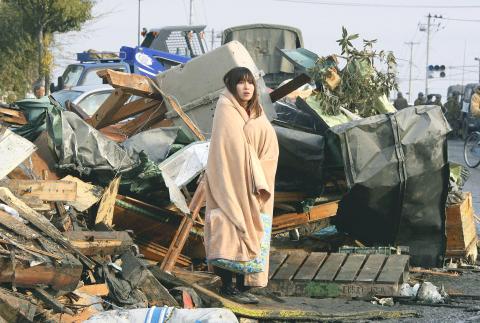
Photo: Reuters / Yomiuri Shimbun
When the photo was taken, at about 7am on March 13, she was looking in the direction of her son Raito’s kindergarten, which was partly submerged and surrounded by piles of debris. Nearly two days after the quake she had yet to find the four-year-old.
“At that point, I thought there was only about a 50 percent chance he was alive,” she recalled recently. “Some people told me the children at the kindergarten were rescued, but others told me that somebody had seen the children all swept away by the tsunami.”
Sugimoto was born and raised in Ishinomaki, a city of 150,000 known for its port and fishing industry before the wall of water unleashed by the magnitude 9.0 offshore quake roared in. About 3,800 people perished, the highest toll for a single city.
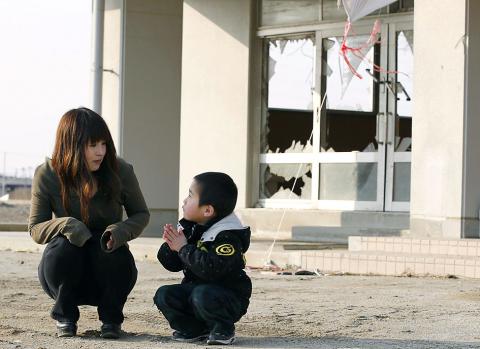
Photo: Reuters
Delivering beverages for her business when the quake struck, she desperately tried to reach the kindergarten, but was forced to flee the tsunami, spending the night in her car.
Reunited with her husband the next day, the two began making the rounds of evacuation centers — first by car, then by bicycle as fuel ran out. Her husband found a boat and paddled his way toward the kindergarten, but found no one there.
It wasn’t until the next day that the couple heard that their son and other children had been rescued by the military from the roof of the kindergarten the morning after the tsunami.
“When I saw Raito in the corner of a room, the next moment I was weeping so hard I couldn’t see anything,” Sugimoto said.
She hugged him and checked his hands, his feet, every bit of his body. She even checked his smell, to be certain it really was him.
Holding him tight, she said “Thank goodness, thank goodness,” over and over.
Nearly a year later, Sugimoto stood in the same place, embracing her son and smiling. Behind her, the gently sloping road was clean, with cars and trucks stopped at a traffic light.
Her smile suggests that her life is back on track, but that is not true. Though the debris was cleared much more quickly than she expected, it will take some time for Sugimoto and her family to get on with their lives.
The house they built four years ago was submerged nearly to its second floor and they lost most of their belongings. What remains is a 31-year-mortgage of about ¥25 million (US$310,000) they still have to pay.
They now live in a rented house, but the lease expires next year. Returning to the old house would mean razing it and rebuilding from scratch.
“I used to love the ocean, but ever since the disaster, I haven’t been to the ocean even once. I want to stay on in Ishinomaki, but far away from the ocean,” she said.
Despite the financial burdens, Sugimoto’s priorities have changed. Though she once worked even through vacations, she has now quit her job to spend more time with her family.
“Now, every single day is precious to me. I realize that time with my family is what is most important,” she said. “Our bond is even tighter now.”
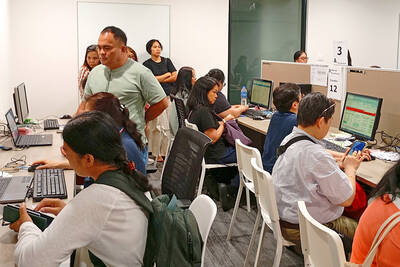
A new online voting system aimed at boosting turnout among the Philippines’ millions of overseas workers ahead of Monday’s mid-term elections has been marked by confusion and fears of disenfranchisement. Thousands of overseas Filipino workers have already cast their ballots in the race dominated by a bitter feud between President Ferdinand Marcos Jr and his impeached vice president, Sara Duterte. While official turnout figures are not yet publicly available, data from the Philippine Commission on Elections (COMELEC) showed that at least 134,000 of the 1.22 million registered overseas voters have signed up for the new online system, which opened on April 13. However,

ALLIES: Calling Putin his ‘old friend,’ Xi said Beijing stood alongside Russia ‘in the face of the international counter-current of unilateralism and hegemonic bullying’ Chinese President Xi Jinping (習近平) yesterday was in Moscow for a state visit ahead of the Kremlin’s grand Victory Day celebrations, as Ukraine accused Russia’s army of launching air strikes just hours into a supposed truce. More than 20 foreign leaders were in Russia to attend a vast military parade today marking 80 years since the defeat of Nazi Germany in World War II, taking place three years into Russia’s offensive in Ukraine. Putin ordered troops into Ukraine in February 2022 and has marshaled the memory of Soviet victory against Nazi Germany to justify his campaign and rally society behind the offensive,
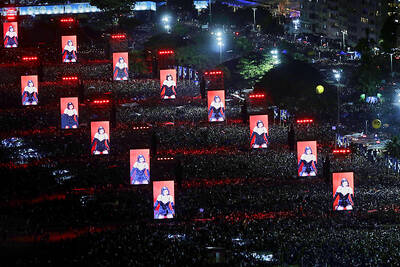
ENTERTAINMENT: Rio officials have a history of organizing massive concerts on Copacabana Beach, with Madonna’s show drawing about 1.6 million fans last year Lady Gaga on Saturday night gave a free concert in front of 2 million fans who poured onto Copacabana Beach in Rio de Janeiro for the biggest show of her career. “Tonight, we’re making history... Thank you for making history with me,” Lady Gaga told a screaming crowd. The Mother Monster, as she is known, started the show at about 10:10pm local time with her 2011 song Bloody Mary. Cries of joy rose from the tightly packed fans who sang and danced shoulder-to-shoulder on the vast stretch of sand. Concert organizers said 2.1 million people attended the show. Lady Gaga
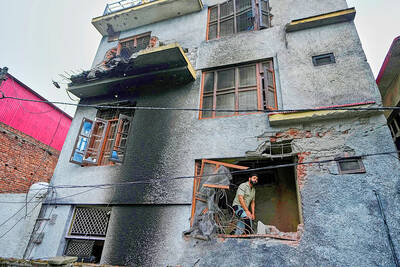
CONFLICTING REPORTS: Beijing said it was ‘not familiar with the matter’ when asked if Chinese jets were used in the conflict, after Pakistan’s foreign minister said they were The Pakistan Army yesterday said it shot down 25 Indian drones, a day after the worst violence between the nuclear-armed rivals in two decades. Pakistani Prime Minister Shehbaz Sharif vowed to retaliate after India launched deadly missile strikes on Wednesday morning, escalating days of gunfire along their border. At least 45 deaths were reported from both sides following Wednesday’s violence, including children. Pakistan’s military said in a statement yesterday that it had “so far shot down 25 Israeli-made Harop drones” at multiple location across the country. “Last night, India showed another act of aggression by sending drones to multiple locations,” Pakistan military spokesman Ahmed